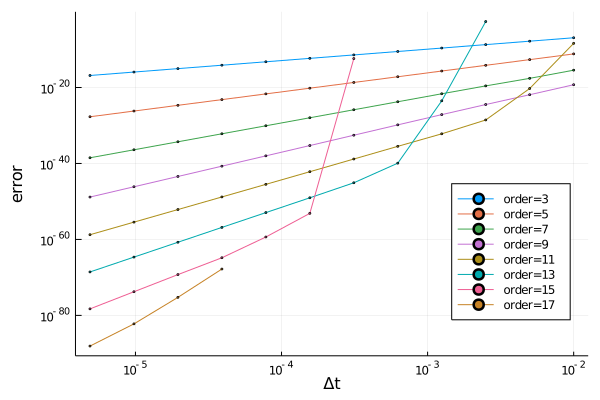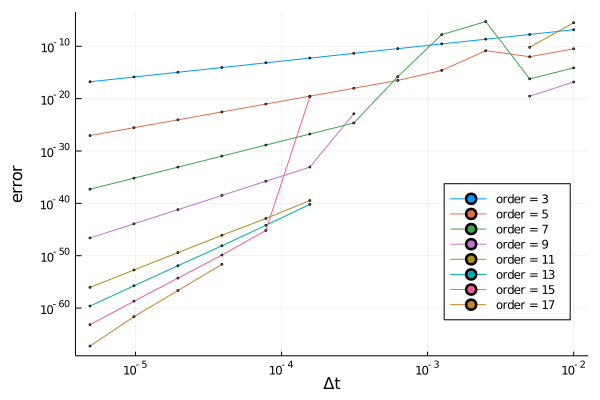Quickstart
Hénon-Heiles Example
We consider the system of Hénon-Heiles satisfied by $u(t)=(u_1, u_2, u_3, u_4)(t)$.
\[\frac{d u }{dt} = \frac{1}{\varepsilon} Au + f(u), \;\;\; u(t_{start})=u_{inn}\in\mathbb{R}^4,\]
where $A$ and $f$ are selected as follows
\[A= \left( \begin{array}{cccc} 0 & 0 & 1 & 0 \\ 0 & 0 & 0 & 0 \\ -1 & 0 & 0 & 0 \\ 0 & 0 & 0 & 0 \end{array} \right) \;\;\;\; \text{ and } \;\;\;\; f(u) = \left( \begin{array}{cccc} 0 \\ u_4\\ -2 u_1 u_2\\ -u_2-u_1^2+u_2^2 \end{array} \right).\]
one chooses for example, $\varepsilon=0.001$ and $u_{in} = (0.12, 0.12, 0.12, 0.12)$
Input parameters
The input arguments use the same format as the ODE package.
Thus, first of all, we must define the arguments necessary to construct the problem (1), namely
- the $f$ function (in the form Julia)
- the initial condition $u_{in}$.
- the initial time $t_{start}$ and final time $t_{end}$.
- the second parameter of the
- the $A$ matrix
- $\varepsilon \in ]0, 1]$
using HOODESolver, Plots
epsilon= 0.0001
A = [ 0 0 1 0 ;
0 0 0 0 ;
-1 0 0 0 ;
0 0 0 0 ]
f1 = LinearHOODEOperator( epsilon, A)
f2 = (u,p,t) -> [ 0, u[4], 2*u[1]*u[2], -u[2] - u[1]^2 + u[2]^2 ]
tspan = (0.0, 3.0)
u0 = [0.55, 0.12, 0.03, 0.89]
prob = SplitODEProblem(f1, f2, u0, tspan);From the prob problem, we can now switch to its numerical resolution.
To do this, the numerical parameters are defined
- the number of time slots $N_t$ which defines the time step $\Delta t = \frac{t_{\text{end}}-t_{start}}{N_t}$ but you can set the value of time step
dtin thesolvecall. - the $r$ order of the method
- the number of $N_\tau$ points in the $\tau$ direction...
- the order of preparation $q$ of the initial condition
The default settings are : $N_t=100$, $r=4$, $N_\tau=32$ and $q=r+2=6$ To solve the problem with the default parameters, just call the solve command with the problem already defined as parameter
sol = solve(prob, HOODEAB(), dt=0.1);solve function prob=HOODEProblem{Float64}(HOODESolver.HOODEFunction{false, 3}(Main.var"#1#2"()), [0.55, 0.12, 0.03, 0.89], (0.0, 3.0), missing, [0 0 1 0; 0 0 0 0; -1 0 0 0; 0 0 0 0], 0.0001, missing),
nb_tau=32, order=4, order_prep=6, dense=true,
nb_t=30, getprecision=true, verbose=100
30/30
35/35Which is equivalent to HOODEAB( order=4, nb_tau=32 )
Exhaustive definition of the parameters
prob: problem defined bySplitODEProblemnb_tau=32: $N_{\tau}$order=4: order $r$ of the methodorder_prep=order+2: order of preparation of initial datadense=true: indicates whether or not to keep the data from the fourier transform, ifdense=false, processing is faster but interpolation can no longer be done.nb_t=100: $N_t$getprecision=dense: indicates whether the accuracy is calculated, the method used to calculate the accuracy multiplies the processing time by 2.verbose=100: trace level, ifverbose=0then nothing is displayed.par_u0: If we have to make several calls tosolvewith the same initial data and in the same order, we can pass in parameter the already calculated data.p_coef: table with the coefficients of the Adams-Bashforth method. This array can be used to optimize several calls with the same parameters.
Exit arguments
As an output, a structure of type ODESolution from DifferentialEquations.jl. This structure can be seen as a function of t, it can also be seen as an array. Example:
julia> sol.probODEProblem with uType Vector{Float64} and tType Float64. In-place: false timespan: (0.0, 3.0) u0: 4-element Vector{Float64}: 0.55 0.12 0.03 0.89julia> sol.algHOODESolver.HOODETwoScalesAB()julia> t=2.5414515472.541451547julia> sol(t)4-element Vector{Float64}: -0.5364409361971507 1.5936478973290051 -0.124482679360465 0.7189258982198888julia> sol[end]4-element Vector{Float64}: 0.36354863065271914 2.0384405589059846 -0.4134978102269046 1.3093799931994603julia> sol(3.0)4-element Vector{Float64}: 0.36354863070081406 2.0384405592395702 -0.4134978103117947 1.3093799933948773
To view the result, you can also use Plot, for example
plot(sol)Linear non-homogeneous case
The following non-homogeneous linear system is considered to be satisfied by $u(t)=(u_1, u_2, u_3, u_4)(t)$
\[\frac{d u }{dt} = \frac{1}{\varepsilon} Au + f(t, u), \;\;\; u(0)=u_in\in\mathbb{R}^4,\]
where $A$ and $f$ are selected as follows
\[A= \left( \begin{array}{cccc} 0 & 0 & 1 & 0 \\ 0 & 0 & 0 & 0 \\ -1 & 0 & 0 & 0 \\ 0 & 0 & 0 & 0 \end{array} \right) \;\;\; \text{ and } \;\;\; f(t, u) = Bu +\alpha t +\beta \;\; \text{ with } \;\; B\in {\mathcal M}_{4, 4}(\mathbb{R}), \alpha, \beta \in \mathbb{R}^4,\]
$B, \alpha, \beta$ are chosen randomly.
We wish to obtain a high precision, so we will use BigFloat real numbers, they are encoded on 256 bits by default which gives a precision bound of about $2^{-256}. \approx 10^{-77}$. At the end, we compare a calculated result with an exact result. For this, you must use the dedicated HOODEProblem type:
using HOODESolver
using Plots
using Randomrng = MersenneTwister(1111)
A=[0 0 1 0 ; 0 0 0 0 ; -1 0 0 0 ; 0 0 0 0]
B = 2rand(rng, BigFloat, 4, 4) - ones(BigFloat, 4, 4)
alpha = 2rand(rng, BigFloat, 4) - ones(BigFloat, 4)
beta = 2rand(rng, BigFloat, 4) - ones(BigFloat, 4)
u0 = [big"0.5", big"-0.123", big"0.8", big"0.7"]
t_start=big"0.0"
t_end=big"1.0"
epsilon=big"0.017"
fct = (u,p,t)-> B*u + t*p[1] +p[2]
prob = HOODEProblem(fct, u0, (t_start,t_end), (alpha, beta), A, epsilon, B)
sol = solve(prob, nb_t=10000, order=8)
sol.absprec7.505703231386974e-36t=big"0.9756534187771"
sol(t)-getexactsol(sol.par_u0.parphi, u0, t)4-element Vector{BigFloat}:
-6.64279126151980067153161931580208824742979191850982976277636805334408440721282e-38
-1.327107408073326332811625797831592452956281353022802107039719778171152704756572e-36
1.238667480493066160810452633414763319915191588129214458039465492274383051382844e-36
-1.155162591602066199571638849512682488383976241147967286559990246684758104590784e-35plot(sol.t,sol.u_tr)Calculation of the exact solution
This involves calculating the exact solution $u(t)$ of the following equation at the instant $t$
\[\frac{d u }{dt} = \frac{1}{\varepsilon} Au + Bu +\alpha t +\beta, \;\;\; u(t_{start})=u_{in}\in\mathbb{R}^4\text{, } A \text{ and }B \text{ are defined above }\]
Let
\[\begin{aligned} M &= \frac{1}{\varepsilon} A + B\\ C &= e^{-t_{start} M}u_{in} +M^{-1} e^{-t_{start} M} (t_{start}\alpha+\beta)+ M^{-2} e^{-t_{start} M} \alpha\\ C_t &= -M^{-1} e^{-t M} (t\alpha+\beta)-M^{-2} e^{-t M} \alpha\\ u(t) &= e^{t M} ( C + C_t) \end{aligned}\]
Which, translated into Julia language, gives the code of the function getexactsol :
function getexactsol(par::PreparePhi, u0, t)
@assert !ismissing(par.matrix_B) "The debug matrix is not defined"
sparse_A = par.sparse_Ap[1:(end-1),1:(end-1)]
m = (1/par.epsilon)*sparse_A+par.matrix_B
t_start = par.t_0
if ismissing(par.paramfct)
return exp((t-t0)*m)*u0
end
a, b = par.paramfct
mm1 = m^(-1)
mm2 = mm1^2
e_t0 = exp(-t_start*m)
C = e_t0*u0 + mm1*e_t0*(t_start*a+b)+mm2*e_t0*a
e_inv = exp(-t*m)
e = exp(t*m)
C_t = -mm1*e_inv*(t*a+b)-mm2*e_inv*a
return e*C+e*C_t
endAccuracy of the result according to the time interval
Linear problem
From a problem of the previous type, as long as we can calculate the exact solution, it is possible to know exactly what the error is. The initialization data being
using HOODESolver
A = [0 0 1 0 ; 0 0 0 0 ; -1 0 0 0 ; 0 0 0 0]
u0 = BigFloat.([-34//100, 78//100, 67//100, -56//10])
B = BigFloat.([12//100 -78//100 91//100 34//100
-45//100 56//100 3//100 54//100
-67//100 09//100 18//100 89//100
-91//100 -56//100 11//100 -56//100])
alpha = BigFloat.([12//100, -98//100, 45//100, 26//100])
beta = BigFloat.([-4//100, 48//100, 23//100, -87//100])
epsilon = 0.015
t_end = big"1.0"
fct = (u,p,t)-> B*u + t*p[1] +p[2]
prob = HOODEProblem(fct,u0, (big"0.0",t_end), (alpha, beta), A, epsilon, B)Note that the floats are coded on 512 bits.
By varying $\Delta t$ from $10^{-2}$ to $5.10^{-6}$ (i.e. nb_t from 100 to 204800) on a logarithmic scale, for odd orders from 3 to 17 we get these errors
Precision of the result with ε = 0.015

Now with the same initial data, order being setted to 6, and $\varepsilon = 0.15, 0.015, \ldots, 1.5\times 10^{-7}$.
Here floats are coded on 256 bits.
Precision of the result with order = 6

Problem with Hénon-Heiles function
u0=BigFloat.([90, -44, 83, 13]//100)
t_end = big"1.0"
epsilon=big"0.0017"
fct = u -> [0, u[4], -2u[1]*u[2], -u[2]-u[1]^2+u[2]^2]
A = [0 0 1 0; 0 0 0 0;-1 0 0 0; 0 0 0 0]
prob = HOODEProblem(fct, u0, (big"0.0",t_end), missing, A, epsilon)The float are coded on 512 bits.
Precision of the result with ε = 0.0017

Now with the same initial data, order being setted to 6, and $\varepsilon = 0.19, 0.019, \ldots, 1.9\times 10^{-8}$.
Here floats are coded on 256 bits.
Precision of the result with order 6
